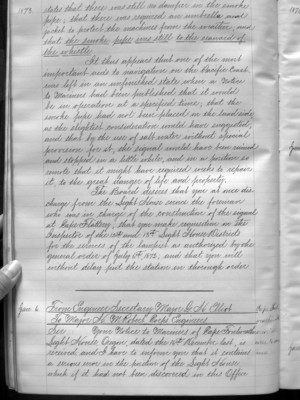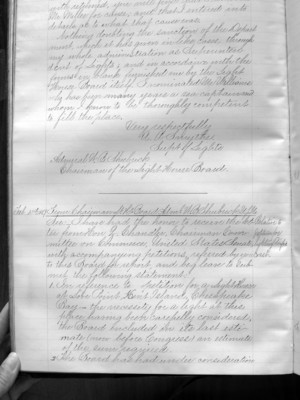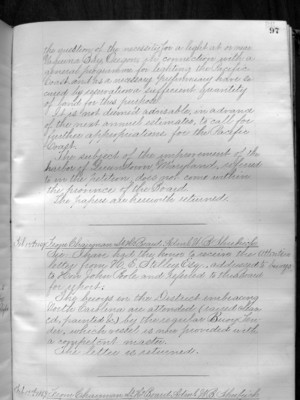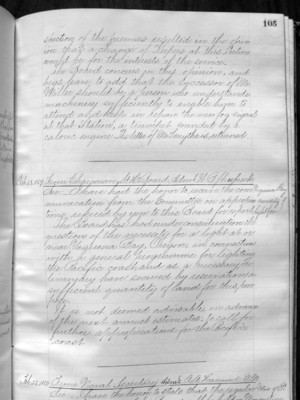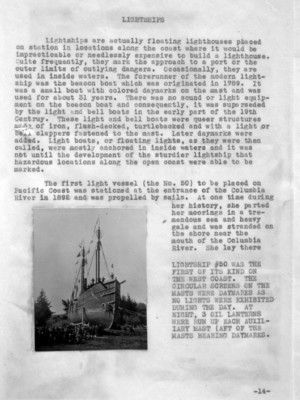Pages That Mention Pacific Coast
1870-73 Lighthouse Board Annual Reports
37
1873.
states that there was still no damper in the smoke pipe; that there was required an umbrella and jacket to protect the machines from the weather; and that the smoke-pipe was still to the seaward of the whistle.
It thus appears that one of the most important aids to navigation on the Pacific Coast, was left in an unfinished state when a Notice to Mariners had been published that it would be in operation at a specified time; that the smoke-pipe had not been placed on the land side as the slightest consideration would have suggested; and that by the use of salt water without special provision for it, the signal would have been ruined and stopped in a little while, and in a position so remote that it might have required weeks to repair it, to the great danger of life and property.
The Board desires that you at once discharge from the Light House service the foreman who was in charge of the construction of the signal at Cape Flattery; that you make requisition on the Inspector of the 12th and 13th Light House Districts for the services of the lampist and authorized by the general order of July 6th, 1872; and that you will without delay put the station in thorough order.
Jan. 6.
From Engineer secretary Major G. H. Elliot. To Majro H. M. Robert. Corps Engineers.
Sir: Your Notice to Mariners of Cape Foulweather Light House, Oregon, dated the 16th December last, is received, and I have to inform you that it contains a serious error in the position of the Light House which if it had not been discovered in this Office
Yaquina Bay Built 1869 to 1871
1
with returned you will find ??? Mr. Miller for cause; and that I entered into details as to what that cause was.
Nothing doubting the sanction of the Department, which it has given in like cases through my whole administration as Superintendent of Lights; and in accordance with the forms in blank furnished me by the Light House Board itself. I nominated Mr. Williams who has been many years a sea captain and whom I know to be thoroughly competent to fill the place.
Very respectfully A. A. Smythe. Supt of Lights
Admiral W.B. Shubrick Chairman of the Light House Board.
__________________________________________________
Feb 13th, 1869
From Chairman L.H. Board Adml. W.B. Shubrick U.S.N
Relative to Petitions for lighting Pacific coast.
Sir: I have had the honor to receive the letter from Hon Z. Chandler, Chairman Committee on Commerce, United States Senate, with accompanying petitions, referred by you to this Board for report, and beg leave to submit the following statement:
1. In reference to petition for a Light House at Love Point, Kent Island, Chesapeake Bay - the necessity for a light at this place having been carefully considered, the Board included in its last estimate (now before Congress) an estimate of the sum required.
2. The Board has had under consideration
2
the question of the necessity for a light at or near Yaquina Bay, Oregon, in connection with a general programme for lighting the Pacific Coast, and as a necessary prelimniary (preliminary???) have secured by reservation a sufficient quantity of land for this purpose. It is not deemed advisable, in advance of the next annual estimates, to call for further appropriation for the Pacific Coast. The subject of the improvement of the harbor of Queenstown, Maryland, referred to in the petition, does not come within the province of the Board. The papers are herewith returned.
______________________________________________
Feb 19th, 1869
From Chairman L.H. Board Adml. W.B. Shubrick
Sir: I have had the honor to receive the letter from H. E. Stilley Esq., addressed to Hon John Poole and referred to this Board for report. The buoys in the District embracing North Carolina are attended ( raised cleaned, painted &c) by the regular Buoy Tender, which vessel, is now provided with a competent master. The letter is returned.
______________________________________________
Feb 19th, 1869
From Chairman L.H. Board Adml. W.B. Shubrick
3
(in)spection of the premises resulted in the opinion that a change of Keepers at this Station would be for the interests of the service. The Board concurs in this opinion, and begs leave to add that the successor of Mr. Miller should be a person who understands machinery sufficiently to enable him to attend and keep in repair the new fog-signal at that Station, a trumpet sounded by a caloric engine. The letter of Mr. Smythe is returned. ______________________________________________
Feb 25, 1869
From Chairman L.H. Board Adml. W.B. Shubrick
Yaquina Bay - necessity of light for
Sir: I have had the honor to receive the communication from the Committee on appropriations (???), referred by you to this Board for report. The Board has had under consideration the question of the necessity for a light at or near Yaquina Bay, Oregon, in connection with a general programme for lighting the Pacific coast, and as a necessary preliminary have secured by reservation a sufficient quantity of land for this purpose. It is not deemed advisable, in advance of the next annual estimates, to call for further appropriations for the Pacific coast ______________________________________________
Feb 25, 1869
From Naval Secretary Adm. A.A. Harwood. U.S.N Notice of Board (Bd ???)
Sir: I have the honor to state that the regular
Coast Guard District narrative histories 1945
33
Lightships are actually floating lighthouses placed on station in locations along the coast where it would be impracticable or needlessly expensive to build a lighthouse. Quite frequently, they mark the approach to a port or the outer limits of outlying dangers. The forerunner of the modern lightship was the beacon boat which was originated in 1789. It was a small boat with colored daymarks on the mast and was used for about 31 years. There was no sound or light equipment on the beacon boat and consequently, it was superseded by the light and bell boats in the early part of the 19th Century. These light and bell boats were queer structures made of iron, flash-decked, turtlebacked and with a light or bell clappers fastened to the mast. Later daymarks were added. Light boats, or floating lights, as they were then called, were mostly anchored in inside waters and it was not until the development of the sturdier lightship that hazardous locations along the open coast were able to be marked.
The first light vessel (the No. 50) to be placed on Pacific Coast was stationed at the entrance of the Columbia River in 1892 and was propelled by sails. At one time during her history, she parted her moorings in a tremendous sea and heavy gale and was stranded on the shore near the mouth of the Columbia River. She lay there
(Image bottom left)
LIGHTSHIP #50 WAS THE FIRST OF ITS KIND ON THE WEST COAST. THE CIRCULAR SCREENS ON THE MASTS WERE DAYMARKS AS NO LIGHTS WERE EXHIBITED DURING THE DAY. AT NIGHT, 3 OIL LANTERNS WERE RUN UP EACH AUXILIARY MAST (AFT OF THE MASTS BEARING DAYMARKS.
